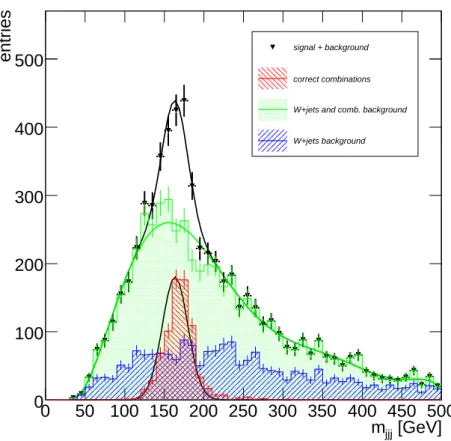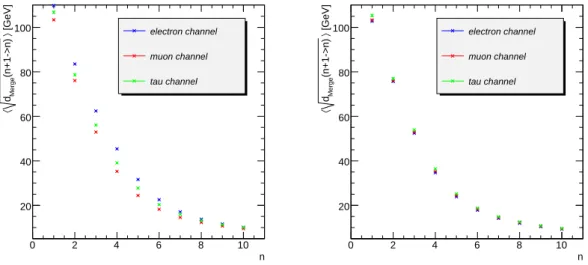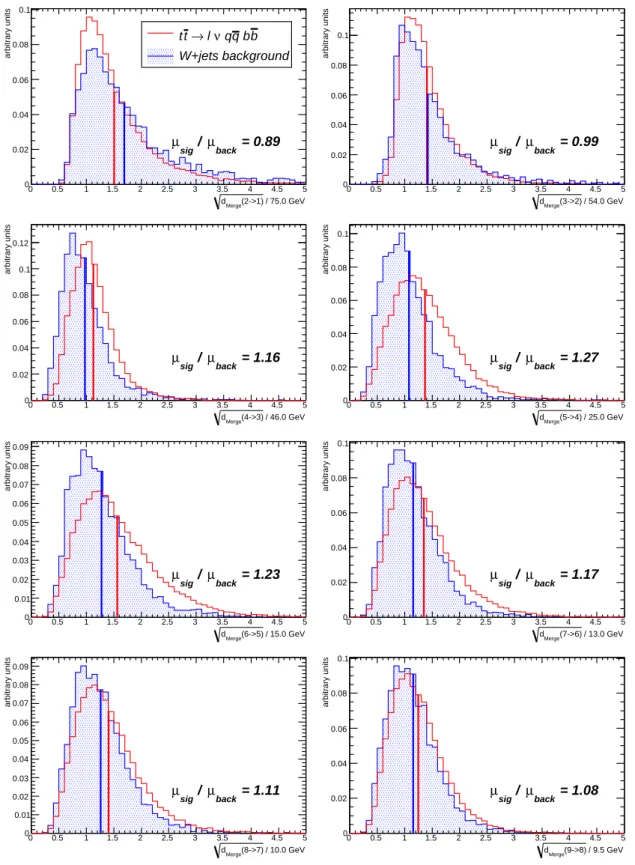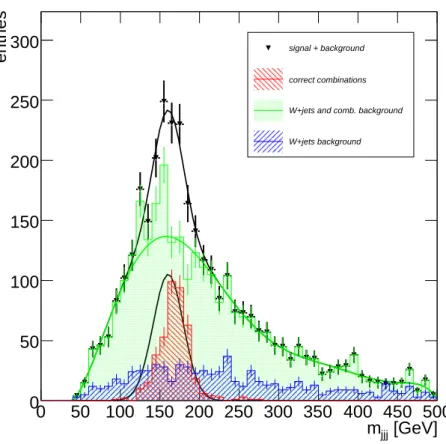Max-Planck-Institut f¨ ur Physik (Werner-Heisenberg-Institut)
Background suppression for a top quark mass measurement in the lepton+jets t t ¯ decay channel
and
Alignment of the ATLAS silicon detectors with cosmic rays
Tobias G¨ ottfert
Vollst¨ andiger Abdruck der von der Fakult¨ at f¨ ur Physik der Technischen Universit¨ at M¨ unchen zur Erlangung des akademischen Grades eines
Doktors der Naturwissenschaften (Dr. rer. nat.) genehmigten Dissertation.
Vorsitzender: Univ.-Prof. Dr. A. J. Buras Pr¨ ufer der Dissertation:
1. Hon.-Prof. Dr. S. Bethke 2. Univ.-Prof. Dr. L. Oberauer
Die Dissertation wurde am 22.12.2009 bei der Technischen Universit¨ at M¨ unchen
eingereicht und durch die Fakult¨ at f¨ ur Physik am 21.01.2010 angenommen.
Background suppression for a top quark mass measurement in the lepton+jets t t ¯ decay channel
and
Alignment of the ATLAS silicon detectors with cosmic rays
Dissertation von
Tobias G¨ ottfert
M¨ unchen
22. Dezember 2009
The investigation of top quark properties will be amongst the first measurements of ob- servables of the Standard Model of particle physics at the Large Hadron Collider. This thesis deals with the suppression of background sources contributing to the event sample used for the determination of the top quark mass. Several techniques to reduce the con- tamination of the selected sample with events from W +jets production and combinatorial background from wrong jet associations are evaluated. The usage of the jet merging scales of a k T jet algorithm as event shapes is laid out and a multivariate technique (Fisher dis- criminant) is applied to discriminate signal from physics background. Several kinematic variables are reviewed upon their capability to suppress wrong jet associations.
The second part presents the achievements on the alignment of the silicon part of the
Inner Detector of the ATLAS experiment. A well-aligned tracking detector will be crucial
for measurements that involve particle trajectories, e. g. for reliably identifying b-quark
jets. Around 700,000 tracks from cosmic ray muons are used to infer the alignment of all
silicon modules of ATLAS using the track-based local χ 2 alignment algorithm. Various
additions to the method that deal with the peculiarities of alignment with cosmic rays are
developed and presented. The achieved alignment precision is evaluated and compared to
previous results.
Eine der ersten Messungen von Observablen des Standardmodells der Teilchenphysik am Large Hadron Collider wird die Untersuchung von Topquark-Eigenschaften sein. Diese Arbeit behandelt die Untergrundunterdr¨ uckung von Ereignissen, die zur verwendeten Ereignisauswahl f¨ ur die Topquark-Massenmessung beitragen. Mehrere Verfahren, um die Kontamination der ausgew¨ ahlten Ereignisse mit Ereignissen aus W +jets-Produktion und kombinatorischem Untergrund zu reduzieren, werden untersucht. Die Jet-Merging-Skalen eines k T -Algorithmus werden als topologische Variablen verwendet und multivariate Tech- niken (eine Fisher-Diskriminante) werden angewandt, um Signal von Physikuntergrund zu trennen. Weitere kinematische Variablen werden auf ihre F¨ ahigkeit zur Unterdr¨ uckung falscher Jetzuordnungen untersucht.
Der zweite Teil dieser Arbeit stellt die Fortschritte beim Alignment der Siliziummod-
ule des inneren Detektors von ATLAS vor. Ein gut alignierter Spurdetektor ist die Vo-
raussetzung f¨ ur die genaue Vermessung von Teilchenspuren, um zum Beispiel verl¨ asslich
b-Quark-induzierte Jets zu identifizieren. Etwa 700 000 Spuren aus kosmischen Myonen
werden verwendet, um die Position aller Siliziummodule von ATLAS mittels des Local-χ 2 -
Alignmentalgorithmus zu bestimmen. Mehrere Erweiterungen der Methode, die sich mit
den Besonderheiten des Alignments mit kosmischen Teilchen befassen, werden eingef¨ uhrt
und pr¨ asentiert. Die erreichte Alignmentpr¨ azision wird bewertet und mit fr¨ uheren Ergeb-
nissen verglichen.
1 Introduction 1
2 Standard Model of particle physics 3
2.1 The Standard Model . . . . 3
2.1.1 Quantum chromodynamics . . . . 4
2.1.2 Electroweak interactions . . . . 4
2.2 Top quark physics . . . . 5
2.2.1 Production mechanisms . . . . 6
2.2.2 Decay processes . . . . 8
3 ATLAS at the LHC 9 3.1 The Large Hadron Collider . . . . 9
3.2 The ATLAS detector . . . . 11
3.2.1 ATLAS coordinates and terminology . . . . 12
3.2.2 Inner Detector . . . . 13
3.2.3 Calorimeter system . . . . 16
3.2.4 Muon system . . . . 17
3.2.5 Magnet system . . . . 18
4 Systematic studies for a top quark mass commissioning analysis 19 4.1 Jet reconstruction . . . . 19
4.1.1 Input objects and calibration . . . . 20
4.1.2 Jet algorithms . . . . 20
4.2 Cut-based top quark mass analysis . . . . 22
4.2.1 Object and event selection . . . . 23
4.2.2 Monte Carlo datasets . . . . 24
i
4.2.3 Mass reconstruction . . . . 26
4.3 Usage of d Merge as event shape variables for background rejection . . . . 29
4.3.1 Cut-based background rejection . . . . 30
4.3.2 Evaluation of multivariate discriminator techniques . . . . 34
4.4 Using d Merge variables to suppress wrong combinations . . . . 42
4.5 Background discrimination using kinematic variables . . . . 45
4.6 Conclusions . . . . 54
5 Alignment studies for the silicon part of the ATLAS Inner Detector 57 5.1 The local χ 2 alignment algorithm . . . . 57
5.1.1 Track-based alignment . . . . 57
5.1.2 The local χ 2 formalism . . . . 58
5.1.3 Tracking and the choice of residuals . . . . 59
5.1.4 Levels of alignment granularity . . . . 60
5.2 Creation of realistic systematic deformations of the ATLAS Inner Detector 61 5.3 Local χ 2 alignment using cosmic ray data . . . . 67
5.3.1 Cosmic ray reconstruction and datasets . . . . 67
5.3.2 Local χ 2 alignment procedure . . . . 70
5.3.3 Quality of the final alignment . . . . 98
5.4 Conclusions . . . 104
6 Conclusions 107
A Additional figures 109
B List of Abbreviations 112
List of Figures 113
List of Tables 116
Bibliography 117
Introduction
The fundamental particles and interactions that make up our universe have been investi- gated for 55 years at the European Organization for Nuclear Research (CERN) located in Geneva, Switzerland. Since then, high energy physics has reached the region of subatomic particles and provided a wealth of insight on the structure of matter and the fundamen- tal laws of nature. In a collaborative effort, the Large Hadron Collider (LHC) has been designed and built during the last 15 years to achieve an unprecedented collision energy of 14 TeV in its proton-proton collisions. Four main experiments were constructed, which aim to allow for physics analyses that test the Standard Model of particle physics and explore the regions where it is no longer valid. One of these experiments is ATLAS (A Toroidal Lhc ApparatuS).
After the successful beam injection in September 2008 and the following cryogenic incident, the accelerator and the experiments were preparing for a restart this autumn.
The major points of work for ATLAS are the successful commissioning of all detector systems to take advantage of, and understand as much as possible, the performance of the experiment, and the preparation of physics analyses to be used for the early data that is now being recorded after the LHC restart.
Top-antitop quark pair production will already set in with a high rate at the early stages of proton-proton collisions. Top quark production and decay is an important topic, since it allows to test the Standard Model to high precision and additionally it appears as background process to many searches for physics beyond the Standard Model.
For a better reduction of backgrounds to top quark decay, the identification of b quark induced jets is of high importance, which can only be achieved with a well-commissioned tracking detector. The alignment of the ATLAS Inner Detector prior to proton-proton col- lisions is performed using muons which originate from interactions of cosmic ray particles with the atmosphere and that traverse the detector. Track-based alignment methods then can determine the positions in space of all modules to enable decent vertex and tracking resolution. Later, the Inner Detector measurements will be refined to their full resolution by alignment with tracks from proton-proton collisions.
This thesis is structured into the following chapters:
• Chapter 2 briefly reviews the Standard Model of particle physics and the properties of top quark production and decay.
1
• Chapter 3 introduces the ATLAS detector. The detector design and its physics requirements are illustrated and the individual subdetectors are described.
• Chapter 4 covers the results from systematic investigations on the main backgrounds for top quark mass reconstruction. The cut-based commissioning analysis that de- termines the top quark mass from the lepton+jets decay channel of top quark pair production is introduced. This is a robust analysis that only relies on basic func- tioning of the detector components and does not use b-quark identification. Event shape variables using the k T jet algorithm are investigated upon their discrimination against background arising from W +jets physics processes and wrong jet association.
A multivariate technique (Fisher discriminant) is introduced and its performance is evaluated. Several other kinematic variables are explored to improve the rejection of W +jets and combinatorial background.
• Chapter 5 presents the results on the alignment of the ATLAS silicon modules within the Inner Detector using cosmic muon data taken in 2008. The local χ 2 alignment algorithm is described and applied to data, together with the improvements that have been made to the software within this thesis. A study on creation of semi-realistic systematic deformations of the Inner Detector is presented. These deformations are used to test the alignment and physics performance of the ATLAS software.
• Chapter 6 presents the summary and conclusions of the thesis, with the important
results highlighted and an outlook to further developments given.
Standard Model of particle physics
2.1 The Standard Model
The Standard Model of particle physics [1] is a set of relativistic quantum field theories.
It is at present the most precise description of elementary particle physics at the micro- scopic scale. It encompasses quantum chromodynamics (QCD) and electroweak theory with quantum electrodynamics (QED) and weak interactions. All components fulfil the requirements of being renormalisable, i. e. their divergences can be cancelled and they yield finite results for the physical observables. They are gauge invariant, meaning there are local gauge symmetries that make it possible to choose certain parameters without changing the dynamics of the theory. The total symmetry group of the Standard Model is the SU (3)⊗ SU (2) ⊗U (1) group, which describes the symmetries of QCD and electroweak theory.
The particle content of the Standard Model is as follows: the fermions of spin 1/2 form the matter particles, whereas the spin 1 bosons are the exchange quanta of the force fields. In the fermion sector, there are six quark flavours, namely up, down, charm, strange, top, and bottom (u, d, c, s, t, b) quarks, which make three generations (or families) of doublets. Each of the quarks appears in three versions with different colour charge in addition to their electroweak charge. The three generations of leptons, namely, electron (e), muon (µ) and tauon (τ ), together with their respective neutrinos, have no colour charge but electroweak charges. The force carrier particles are the massless photons (γ ), the massive weak interaction gauge bosons W ± and Z, and the eight massless gluons (g) that mediate the strong force. In addition, the favoured mechanism for breaking the electroweak symmetry necessitates that there exists at least one spin 0 boson, the Higgs boson (H), which is the only elementary particle of the Standard Model not yet observed. The fourth elementary force known, gravity, has negligible influence at the microscopic scale and is not included in the Standard Model.
All experimental data up to energies of a few hundred GeV strongly support the Standard Model calculations and make it one of the best-tested theories in physics up to now. However, several areas of the theory indicate that it cannot be valid up to energies higher than a few TeV and therefore strongly motivate the search for physics and theories beyond the Standard Model. Amongst the most promising candidates are supersymmetry, theories with extra dimensions and string theory, that strive for solving some or all of the
3
problems of the Standard Model. To observe phenomena predicted by these models, a firm understanding of the Standard Model is needed.
2.1.1 Quantum chromodynamics
QCD [2, 3] is the part of the Standard Model describing strong interactions. It is based on the symmetry group SU (3) with six different quark flavours being colour triplets and eight gluon fields (together called partons). Leptons and the gauge bosons of electroweak theory do not carry colour charges and thus do not participate in strong interactions.
Unlike the photon in QED, gluons carry colour charges themselves, allowing for self- coupling in 3-gluon and 4-gluon vertices. Therefore QCD is a non-Abelian theory, meaning that the generators of the algebra do not commute. Other striking features of QCD are confinement and asymptotic freedom, i. e. the impossibility of observing free quarks outside of bound hadron states and the asymptotic vanishing of the coupling for interactions with high momentum transfer (deep inelastic processes). The QCD coupling α s varies as a function of the four momentum transfer Q, as given by (in next-to-leading order, NLO):
α s (Q 2 ) = α s (µ 2 ) 1 + α s (µ 2 )β 0 ln Q µ
22. (2.1)
This equation gives the evolution of α s from a known scale µ 2 to a different scale Q 2 , with β 0 > 0 being the first term in the expansion of the β-function of the renormalisation group equation. It can be seen that for growing Q 2 , α s asymptotically vanishes, which describes the asymptotic freedom. For small Q 2 , α s eventually diverges, and the region of confinement is reached, where perturbative expansions cannot be done anymore. The current knowledge of α s at the Z mass is α s (M Z
0) = 0.1184 ± 0.0007 [4].
Confinement also results in the observation of jets in hadron collisions, which are narrow streams of hadronic particles created in hard parton collisions. Jets arise due to the creation of new colourless quark-antiquark pairs from the vacuum when trying to separate bound quarks in a hard interaction.
2.1.2 Electroweak interactions
Electroweak theory [5–8] unifies weak interactions and electromagnetism. Its Lagrangian
obeys the gauge group SU (2) ⊗ U (1). It is a chiral theory in the sense that it affects
right-handed and left-handed fields differently. All right-handed fermionic fields are elec-
troweak singlets, whereas the left-handed fields are doublets. This forbids mass terms for
the fermions, and they are reintroduced into the Standard Model together with W ± and
Z masses by the mechanism of electroweak symmetry breaking. The standard way to intro-
duce the symmetry breaking is via the Higgs mechanism [9]. It does so by spontaneously
breaking the symmetry group via a doublet of complex scalar fields Φ with a non-vanishing
vacuum expectation value (v ≈ 246 GeV). Three of the four degrees of freedom of Φ are
absorbed into the longitudinal degree of freedom of massive spin-1 bosons (of the W ± and
Z), while the photon stays massless. The remaining degree of freedom is physical and
should be found as the Higgs boson. A huge experimental effort is undertaken to find this
last missing piece in the Standard Model, especially at the various LHC experiments.
Weak interactions are the only Standard Model interactions that change flavour. The weak eigenstates of the fermions, where W bosons couple to, are not the eigenstates of the freely propagating particles, the mass eigenstates. The mixing of the down-type quark mass eigenstates into the weak eigenstates is parameterised in the 3×3 Cabibbo-Kobayashi- Maskawa (CKM) matrix [10, 11]. The mixing of the neutrino mass eigenstates into their weak eigenstates is parameterised in the 3×3 Pontecorvo-Maki-Nakagawa-Sakata (PMNS) matrix [12, 13]. The weak and mass eigenstates for up-type quarks and charged leptons are chosen to be identical.
2.2 Top quark physics
The top quark plays an important role in high energy physics [14]. It is by far the heaviest observed elementary particle. The discovery of its existence was made in 1995 by the CDF and D0 collaborations [15, 16] at the TeVatron collider at Fermilab. The current combined measurements of the two detectors [17] result in a top quark mass of 173.1 ± 1.3 GeV 1 .
The top quark carries a number of interesting properties, which make it special amongst the Standard Model quarks:
• Due to its short lifetime, the top quark is the only quark that decays as a bare quark, i.e. before it can form bound states. The top decay width at NLO is calculable to be Γ t = 1.36 GeV [18]. This corresponds to a lifetime of about 0.5 · 10 −24 s, which is too short to observe bound states involving top quarks. This is also not enough time for chromomagnetic spin depolarisation, and the top quark passes on its spin to its decay particles.
• The Yukawa coupling of the top quark, i. e. the coupling to the Higgs boson, as given by √
2m t /v, is almost unity, which is already interesting on its own. Since the top quark has the largest Yukawa coupling of all quarks, it will play an important role in understanding the mechanism of electroweak symmetry breaking.
• Quantum electroweak theory links the mass of the Higgs boson with the masses of the W boson and the top quark via virtual loop corrections. This gives the possibility to constrain the Higgs boson mass by measuring the two other masses at high precision.
Some properties of the top quark are already known quite precisely, most notably the mass, while many others are still unmeasured or only known vaguely. For example, the electric charge of the top quark has not yet been measured, which leaves the possibility that the observed particle is in fact some exotic type of quark having an electric charge other than 2/3. Recent analyses however exclude this scenario at 92 % CL [19]. At the LHC, the charge of the top quark can be measured with an expected precision of O(10 %) [14].
Finally, a good understanding of top quark properties and production and decay mech- anisms is also essential for other physics at the ATLAS detector: top quark production and decay processes can serve as important data to calibrate and commission the detector.
Moreover, almost all analyses that search for physics beyond the Standard Model have to cope with top quark production and decay as background processes.
1
For the whole of this thesis natural units will be used, i. e. ¯ h = c = 1
t
q t q
t t t
t t
t
+ +
g
g g
g g
g
Figure 2.1: The lowest-order Feynman diagrams contributing to t ¯ t production. These are q q-annihilation (upper) and gluon-gluon-fusion (lower). ¯
2.2.1 Production mechanisms
The production mechanisms of top quarks at hadron colliders are twofold: There are top-antitop pair production and single top quark production mechanisms. The Feynman diagrams contributing to t t ¯ production at lowest order are shown in figure 2.1. These are q q-annihilation and gluon-gluon-fusion. The Feynman diagrams contributing to single top ¯ quark production at lowest order are shown in figure 2.2. These are s-channel production, two t-channel processes and the associated production of a top quark with a W boson.
The cross sections for these processes can be calculated by factorizing them into the hard scattering process of the two partons and the parton longitudinal momentum distribu- tion functions (PDFs) in the incoming protons. The matrix element of the parton-parton interaction can be calculated and is denoted with ˆ σ i,j for two partons of type i and j. The PDFs f i (x i , µ 2 F ) are not calculable from the theory, but rather are the results of parame- terised fits to data from deep-inelastic scattering and other experiments. The total cross section for top quark pair production is then given by
σ t t ¯ ( √
s, m 2 t , µ 2 r , µ 2 F ) = X
i,j=q,¯ q,g
Z
dx i dx j f i (x i , µ 2 F )f j (x j , µ 2 F )·ˆ σ ij→t ¯ t ( √
s, m 2 t , x i , x j , µ 2 r , µ 2 F ) , (2.2) where √
s denotes the centre-of-mass energy of the partonic collision, x i and x j are the momentum fractions of the respective protons that the partons i and j carry. The symbol µ r denotes the renormalisation scale at which the matrix element calculation is performed, and µ F is the factorisation scale at which the parton density functions are evaluated. A usual choice is to set µ r = µ F = m t .
Single top quark production is calculated to have about 50 % of the cross section of top quark pair production. A comparison of calculated production cross sections at LHC energies is given in table 2.1. From the cross sections one can see that at an integrated luminosity of 100 fb −1 , which is the design luminosity per year expected for the LHC experiments, top quarks will be produced in high abundance (about 100 million pairs).
This means that every measurement of top quark properties will soon be dominated by
systematic uncertainties.
t
q
′b q
W
q
b q′
t
q
q′
W
W
g
t
b
b
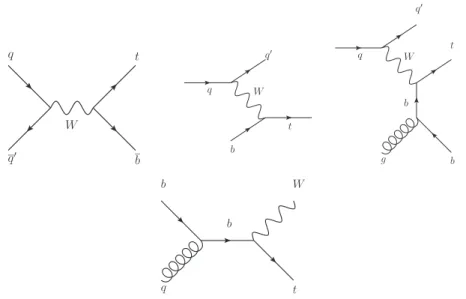
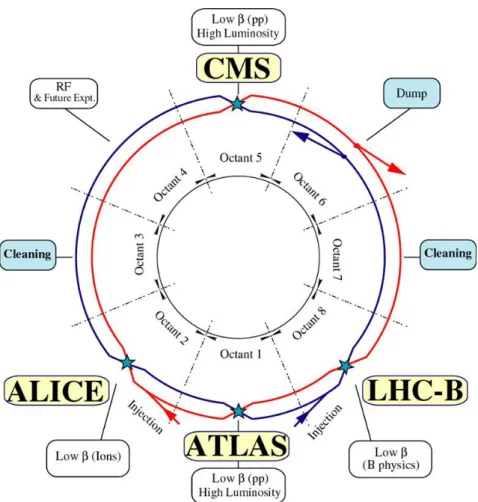
![Figure 3.2: Computer generated sketch of ATLAS with its subsystems and dimensions labelled [31].](https://thumb-eu.123doks.com/thumbv2/1library_info/4014939.1541347/20.892.130.758.180.558/figure-computer-generated-sketch-atlas-subsystems-dimensions-labelled.webp)
![Figure 3.5: A computer generated sketch of the ATLAS muon system [31].](https://thumb-eu.123doks.com/thumbv2/1library_info/4014939.1541347/26.892.210.684.154.506/figure-computer-generated-sketch-atlas-muon.webp)
